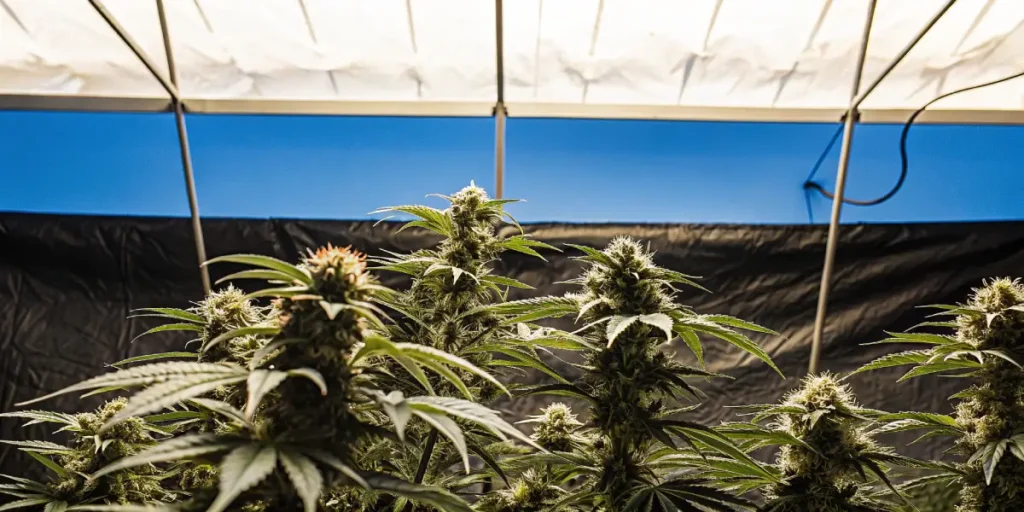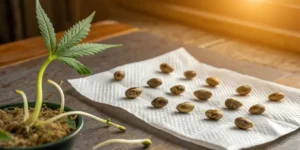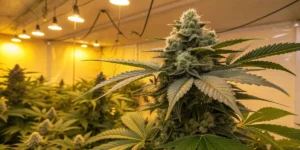CBG Force is a unique cannabis strain specifically bred to yield high levels of cannabigerol (CBG), a non-psychoactive compound lauded for its potential therapeutic benefits. Growing CBG Force requires attention to detail, as this strain needs specific conditions to thrive and produce the desired CBG content. The growing process can be rewarding for enthusiasts looking to explore the lesser-known aspects of cannabis cultivation.
Start by selecting high-quality CBG Force seeds from a reputable supplier. Ensure your seeds have a genetic guarantee for high CBG content. Germinate the seeds using a simple method like the paper towel technique, which involves placing the seeds between moist paper towels and keeping them in a warm, dark place until they sprout. Once the seedlings emerge, transfer them to small pots filled with a nutrient-rich growing medium.
CBG Force plants prefer a controlled indoor environment where conditions can be easily managed. Use grow lights such as LED or HPS lamps to provide sufficient light, mimicking the natural sunlight cycle. Maintain a temperature between 70-80°F (21-27°C) and relative humidity around 40-50%. Ensure ventilation is adequate to prevent mold and mildew growth, as these can harm the plants and affect the CBG production.
As the plants grow, it’s crucial to monitor the nutrient intake. Use fertilizers high in nitrogen during the vegetative phase and switch to phosphorus-rich nutrients once flowering begins. Regularly check the pH level of your water and soil, aiming for a range of 6.0 to 7.0 to keep the plants healthy. Trim and prune the foliage to promote better airflow and light penetration to lower parts of the plant.
Harvesting CBG Force at the right time is vital to maximize CBG content. Unlike other cannabis strains harvested at peak THC content, CBG Force should be harvested earlier when the trichomes are milky and not amber. This ensures higher CBG levels, as CBG converts to THC and other cannabinoids if left to mature for too long. Dry and cure the harvested buds properly to preserve cannabinoid content and improve flavor.
CBG force Strain Overview: Traits, Effects & Genetics
CBG Force is an innovative cannabis strain that has quickly gained attention in the cannabis community for its unique profile, rich in Cannabigerol (CBG). CBG, often referred to as the “mother of all cannabinoids,” is the precursor from which other cannabinoids like THC and CBD are synthesized. As such, CBG Force offers a distinctive cannabinoid blend that diverges from the more common THC and CBD dominance found in traditional strains. With a cannabinoid content significantly skewed towards CBG, this strain represents a pioneering exploration into the diverse effects and benefits of cannabinoids beyond THC and CBD.
The physical traits of CBG Force typically include dense, resinous buds that exhibit a frosty appearance due to the abundant trichomes characteristic of high-CBG strains. Growers often note the vibrant green coloration and subtle orange pistils that provide a striking contrast. The aroma profile is another highlight, presenting a mild earthy scent with subtle hints of citrus and pine. When cultivated under optimal conditions, CBG Force tends to have a balanced structure, allowing for reproduction of tight nodes and a plant that is not too tall, making it manageable for growers both indoors and outdoors.
In terms of effects, CBG Force is celebrated for its non-psychoactive properties which encourage a clear-headed and calm state. Unlike THC-dominant varieties, users frequently report a sense of focus and well-being without the attendant high. This makes CBG Force an ideal choice for consumers seeking therapeutic benefits without the psychoactive experience. It is known for potential benefits in reducing inflammation, improving digestive health, and offering neuroprotective properties, making it a potential candidate for those seeking relief from various conditions while maintaining day-to-day functionality.
The genetic composition of CBG Force is carefully engineered to maximize CBG content while minimizing THC levels to less than 0.1%. It embodies a sophisticated selection process aimed at breeding cannabinoids selectively to achieve specific therapeutic outcomes. The strain’s genetics reflect a mix of ancestral cannabis strains chosen for their ability to produce elevated CBG levels, representing a significant breakthrough for cultivators aiming to cater to a growing interest in diverse cannabinoids. This innovation in genetic selection underscores the commitment to exploring the full spectrum of cannabis’s therapeutic potential.
Optimal Environment to Grow CBG Force Successfully
CBG Force is a remarkably versatile strain that requires a precise and controlled environment for optimal growth. Since it is specifically bred for high cannabigerol (CBG) content, understanding the environmental factors that support its growth is crucial. Starting with temperature, maintaining a stable range between 70-85°F (21-29°C) is ideal. This range supports robust plant development while preventing heat stress during the day and respiratory distress during cooler nights.
Humidity is another critical component in cultivating CBG Force. During the vegetative phase, the relative humidity should be kept around 60% to ensure the plant’s metabolic processes function efficiently. As the plant transitions to the flowering stage, reducing humidity to 40-50% is advisable. This decrease helps mitigate the risk of mold and mildew while supporting the development of dense, robust flowers rich in CBG.
Lighting is a fundamental component of the growing process. CBG Force, like many cannabis strains, thrives under a light schedule with significant intensity. Using a mix of LED and full-spectrum lights, growers should aim to provide approximately 18 hours of light per day during the vegetative stage and 12 hours once flowering commences. Ensuring the light is evenly distributed across the canopy helps maximize growth and CBG content.
Proper soil and nutrition are indispensable for the health of CBG Force plants. Opt for a nutrient-rich soil with excellent drainage properties to avoid root rot. It is crucial to supply a balanced mix of macronutrients like nitrogen, phosphorus, and potassium during the vegetative stage and adjust the nutritional needs to favor phosphorus and potassium during the flowering phase. Regular pH checks, aiming for a level between 6.0 and 7.0, ensure nutrient absorption is optimized.
Ventilation plays a pivotal role in the optimal growth of CBG Force. Adequate airflow mitigates issues caused by excessive humidity and temperature while supporting gas exchange necessary for photosynthesis. Installing oscillating fans and an exhaust system that exchanges indoor air frequently will prevent pest infestations and create a more uniform environment. Additionally, maintaining hygienic conditions in the growth environment is essential to deter mold and pests, ensuring that CBG Force plants reach their full potential.
Grow Room Setup for cbg force Plants
Setting up an ideal grow room for CBG Force plants is crucial to maximizing their potential yields and ensuring high-quality cannabinoid production. CBG Force is a strain bred specifically for its high cannabigerol (CBG) content, often requiring a slightly different approach compared to traditional THC-rich strains. The environment you create plays a pivotal role in the plant’s development, and attention to detail in your grow room setup can help in achieving the best results.
The first consideration is the space and lighting. CBG Force plants need ample room to spread out and thrive, so ensure your grow room can accommodate their growth. Ideally, use LED grow lights, which are energy-efficient and produce less heat, reducing the risk of overheating your plants. Aim for a light spectrum that supports all growth stages, and ensure an even distribution of light by adjusting the height and angles of your light fixtures. Maintain a light schedule of 18 hours on and 6 hours off during the vegetative stage, shifting to a 12/12 schedule for the flowering phase to mimic natural seasonal light changes.
Next, focus on ventilation and temperature control. CBG Force plants prefer moderate temperatures, ideally between 70°F to 80°F (21°C to 27°C). Installing fans and ventilation systems can help keep air circulating and maintain optimal temperatures. This will also aid in controlling humidity levels, which should remain between 40% to 60% during the vegetative phase and slightly lower during flowering to prevent mold and mildew. A dehumidifier might be necessary if humidity levels are too high.
Finally, pay attention to the growing medium and nutrient supply. CBG Force can be cultivated in soil or hydroponic systems, each with its benefits. Soil is typically easier for beginners and offers natural nutrients, while hydroponics can lead to faster growth rates and larger yields. Regardless of the method, use a well-balanced nutrient formula tailored for cannabis plants, with a particular focus on nitrogen during the vegetative stage and phosphorus and potassium during flowering. Regularly test your water’s pH levels, aiming for a range of 6.0 to 7.0 in soil, and 5.5 to 6.5 in hydroponic systems, to ensure optimal nutrient uptake.
Indoor Growing Tips for CBG Force
CBG Force is a unique cannabis strain specifically bred to maximize the production of Cannabigerol (CBG), a non-psychoactive cannabinoid known for its potential therapeutic benefits. When growing CBG Force indoors, one must focus on optimizing environmental conditions to achieve the best results. This includes controlling temperature, humidity, and light exposure, as these factors are pivotal in influencing plant growth and cannabinoid production.
Temperature control is crucial during the indoor cultivation of CBG Force. Maintaining a stable environment with daytime temperatures between 70-80°F and slightly cooler nighttime temperatures can help prevent stress and encourage healthy growth. Additionally, proper air circulation is essential to eliminate hot spots and excess humidity that could create an environment conducive to mold and pests.
Lighting plays a significant role in the indoor cultivation of CBG Force. High-Intensity Discharge (HID) lights or LED grow lights are recommended as they provide the full spectrum of light needed for photosynthesis. Ensuring your plants receive 18 hours of light during the vegetative stage and 12 hours during the flowering stage is essential for healthy growth. Adjusting light intensity and proximity to the plants can further enhance their development.
Humidity management is another critical aspect of growing CBG Force indoors. During the vegetative stage, it’s advisable to maintain relative humidity levels between 40-70%. As the plants enter the flowering stage, gradually reduce humidity to 40-50% to prevent mold and mildew development. Using a hygrometer can help monitor these levels accurately and guide necessary adjustments.
Finally, soil quality and nutrients should not be overlooked. CBG Force thrives in a well-draining, nutrient-rich soil blend that can support its vigorous growth. Introducing a balanced mix of nutrients, including nitrogen, phosphorus, and potassium, is vital during various growth stages to ensure plants receive the essentials for robust health and maximized CBG content.
Outdoor Growing Tips for CBG Force
CBG Force is a particular variety that focuses on producing high levels of Cannabigerol (CBG), a cannabinoid gaining attention for its potential medical benefits. When planning to grow CBG Force outdoors, selecting the correct location is the first critical step. Look for a spot that receives full sunlight, ideally at least six hours of direct sun exposure a day. This ensures that your plants can photosynthesize effectively, leading to robust growth and higher CBG production.
Soil quality is another crucial factor for the successful outdoor cultivation of CBG Force. The plants thrive in nutrient-rich, well-draining soil. A mix that includes compost or organic matter can provide the desired nutrition and aeration. It’s advisable to test your soil pH to ensure it falls within the 6.0-7.0 range, which is optimal for cannabis. Amending the soil with lime or sulfur can help adjust the pH if needed. Regularly monitoring the soil’s nutrient levels and pH throughout the growing season can help prevent deficiencies that may affect plant health and cannabinoid yield.
Watering practices are vital for maintaining the health of your CBG Force plants. It’s important to strike a balance, as both over-watering and under-watering can have adverse effects. Depending on your climate, you may need to water the plants more frequently during hot periods. Aim to water the plants deeply, but allow the top inch of soil to dry out between watering. This promotes healthy root development and prevents root rot. Mulching can also be beneficial in maintaining soil moisture and suppressing weed growth.
Pest control and disease management are essential aspects of outdoor growing. Common pests such as aphids, spider mites, and caterpillars can damage your CBG Force plants. Consider using organic pesticides or introducing beneficial insects like ladybugs to control pest populations. Additionally, keeping the area clean and debris-free reduces the risk of fungal infections, which thrive in damp, cluttered environments. Regularly inspect your plants for signs of stress or pest activity, and act promptly if issues arise.
Finally, timing your harvest is crucial to maximize CBG content. Harvest CBG Force plants based on the trichomes’ appearance; they should change from clear to a milky white. This stage often coincides with the pistils turning a reddish-brown color. Harvesting at the right time ensures that you capture the peak cannabinoid profile of your plants. Proper curing and storage afterward will also help preserve the quality of the CBG-rich flowers for future use.
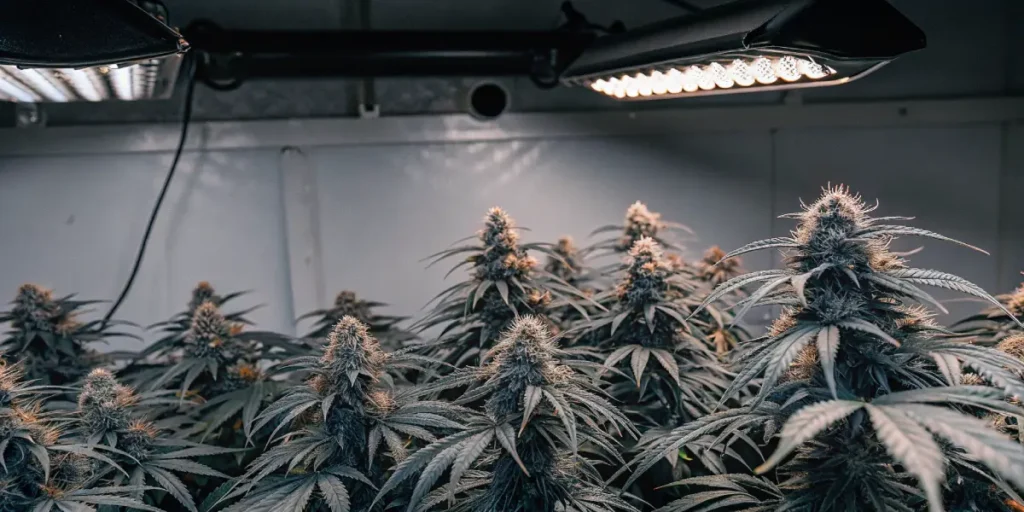
How to Germinate & Propagate CBG Force
CBG force is a specially bred strain of cannabis that prioritizes the production of Cannabigerol (CBG), which is often referred to as the “mother of all cannabinoids.” Germinating CBG force seeds can be quite rewarding, leading to plants that not only thrive but produce significant concentrations of this unique cannabinoid. The first step in a successful CBG growing journey is to properly germinate the seeds. Start by selecting high-quality seeds from a reliable source to ensure the best results.
Begin the germination process using the paper towel method, which is simple yet effective. Moisten a couple of paper towels with distilled water, ensuring they are damp but not overly saturated. Place your CBG force seeds between the layers of the damp paper towel, and carefully position them on a plate. Cover the seeds with another plate to create a dark, humid environment that mimics the ideal conditions for germination. Leave the setup in a warm area, maintaining a temperature around 70 to 75 degrees Fahrenheit. Check the moisture level daily, ensuring the paper towels remain damp but not soaked.
After 3 to 7 days, your CBG force seeds should start to sprout with tiny roots, known as radicles, emerging from their shells. Once they reach about a quarter of an inch in length, it’s time to transition them into propagation. Gently plant the germinated seeds in a small pot filled with a seed-starter soil mix. Ensure the soil is light and airy to provide excellent drainage and support healthy root development. Plant the seeds approximately half an inch deep in the soil and cover lightly.
As the seedlings grow, provide them with ample light to support robust growth. Ideally, they should receive 18 to 24 hours of light per day. Utilize high-quality LED grow lights to encourage efficient photosynthesis while keeping energy consumption manageable. Ensure the environment maintains a consistent temperature of 70 to 75 degrees Fahrenheit and keep the humidity levels around 60% to 70% to optimize the growing conditions.
Once the seedlings are strong and have developed a few sets of true leaves, they can be transplanted into larger pots or directly into your garden. Be sure to acclimate them gradually to prevent shock. By following these detailed germination and propagation steps, your CBG force plants will have a sturdy foundation, maximizing their potential for producing high CBG levels and thriving throughout their life cycle.
Vegetative Stage: Nurturing Your cbg force Plants
The vegetative stage is a crucial phase in the lifecycle of your cbg force plants, where the primary goal is to encourage robust and healthy growth. During this stage, plants focus on establishing strong roots and vibrant foliage, setting the foundation for successful flowering later on. It is essential to provide them with the appropriate conditions to thrive. CBG force plants require a consistent light schedule of 18-24 hours of light per day to ensure optimal growth. Use full-spectrum lights that mimic natural sunlight to give your plants the best chance of healthy development.
Besides to correct lighting, maintaining the right temperature and humidity levels is vital. During the vegetative stage, aim to keep temperatures between 70-85°F (20-30°C) during the day and slightly cooler at night. Relative humidity should be around 40-60%, which creates a conducive environment for your plants to absorb moisture and nutrients effectively. Regularly check the environmental conditions and make adjustments as needed, either manually or through automated systems, to maintain stability.
Nutrition plays a pivotal role in the health and vigor of cbg force plants during the vegetative stage. Provide a balanced nutrient solution with a higher nitrogen content, as nitrogen is key to leafy growth and chlorophyll production. It is advisable to start feeding with half-strength nutrient solutions and observe how your plants respond, gradually increasing the concentration to full strength. Be observant of any signs of nutrient deficiency or toxicity; your plants’ leaves and growth patterns will guide you in making necessary adjustments.
Regular pruning and topping can help your cbg force plants grow in a more controlled and manageable way. By topping the plants, you can encourage bushier growth and more budding sites, which is beneficial for increasing yields. Remove any yellowing or damaged leaves promptly to prevent the spread of potential diseases and to keep the energy focused on healthy growth. Additionally, consider using low-stress training (LST) techniques to maximize light exposure and airflow through the plant canopy.
Lastly, ensure your plants have excellent air circulation to strengthen their stems and reduce the risk of mold and pests. Utilize fans within your grow space to create a gentle breeze, mimicking natural wind conditions. This airflow also assists in regulating temperature and humidity levels, further enhancing the growing environment for your cbg force plants. By providing consistent care and optimal conditions during the vegetative stage, you set your cannabis plants up for a successful transition to the flowering stage and a bountiful harvest.
Flowering cbg force: What to Expect
Flowering CBG Force strains present unique characteristics that set them apart from typical cannabis varieties. CBG, or Cannabigerol, is a lesser-known cannabinoid in cannabis plants, often dubbed the “mother of all cannabinoids” due to its role as a precursor to THC and CBD. When cultivating CBG-specific strains like CBG Force, growers can expect a distinctive flowering phase tailored towards maximizing CBG content. The cultivation and flowering of CBG Force require careful attention to timing, environmental conditions, and growing techniques to ensure optimal cannabinoid expression and plant health.
The flowering period for CBG Force typically spans between 7 to 9 weeks, depending on growing conditions and specific phenotypes. During this phase, growers should anticipate a robust development in bud size and resin production but not necessarily high THC levels, as the primary focus is on cultivating rich CBG concentrations. It’s crucial for growers to maintain an optimal light cycle—generally 12 hours of light and 12 hours of darkness per day—to encourage healthy flowering. Additionally, controlling the temperature and humidity levels within the grow space ensures that plants thrive and produce maximum cannabinoids.
As CBG Force matures, buds may appear less dense than high THC or CBD strains, but they will exhibit a rich coating of trichomes, signaling a high resin production. This trichome development is a visual indication of the rich CBG content. Growers should monitor the trichome color and pistil change as harvest time approaches, ensuring they capture the plant when its cannabinoid profile is optimal. Furthermore, during the final stages of flowering, a rigorous nutrient regimen tailored to CBG production is advisable to enhance both yield and cannabinoid quality. This period requires patience and precision, as the characteristics of CBG Force demand slightly different nutrient balances compared to other cannabinoid-rich strains.
The flowering of CBG Force is an exciting phase for growers targeting high CBG yield, offering both challenges and rewards. By identifying and adhering to the specific needs of CBG Force during this critical period, growers can ensure a successful harvest that highlights the unique properties of CBG. This distinctive approach not only enriches the grower’s understanding of cannabinoid cultivation but also contributes to the broader appreciation and application of non-psychoactive cannabinoids in the holistic cannabis industry.
Feeding cbg force: Fertilizers & Nutrient Schedule
Feeding your CBG Force plants correctly is essential for achieving optimal growth and maximizing the unique cannabinoid content of this strain. CBG Force plants, similar to other types of cannabis, require a balanced diet of primary, secondary, and trace nutrients to thrive. The key macronutrients essential for your plants include nitrogen (N), phosphorus (P), and potassium (K), often referred to as the N-P-K ratio on fertilizer packaging. To start, ensure a high nitrogen concentration during the vegetative stage to promote lush, vigorous growth.
As the plants transition from the vegetative stage to the flowering stage, it’s important to adjust the nutrient mix to support bud development. During flowering, reduce nitrogen levels while gradually increasing phosphorus and potassium. Phosphorus is crucial for the development of flowers and overall reproductive success, whereas potassium contributes to root health and general stress resistance. Implement a balanced feeding schedule to prevent nutrient lockout, ensuring nutrients are readily available to your CBG Force plants when required.
A nutrient schedule tailored to the grow medium—a soil or hydroponic system—will yield the best results. In soil, natural amendments like compost or worm castings can naturally supplement the plants’ nutritional needs, benefiting microbial activity essential for healthy roots. In hydroponics, closely monitor and adjust nutrient solution strengths with tools like electrical conductivity (EC) meters to prevent overfeeding. Constantly observe your plants for signs of nutrient deficiencies or excesses, adjusting the feeding regimen as needed to maintain healthy growth.
Beyond the primary nutrients, CBG Force plants also need secondary nutrients like calcium and magnesium and trace elements like zinc and iron. Incorporate these essential elements through the use of a high-quality, full-spectrum cannabis nutrient product or supplement as required. Remember, consistent monitoring and slight adjustments based on environmental changes or plant feedback are key. With the right feeding strategy and nutrient schedule, your CBG Force plants can produce robust, high-quality yields rich in cannabidiol (CBG), ensuring the best cultivation experience.
Pest and Disease Prevention for Healthy Cannabis Plants
Growing healthy cannabis plants with optimal yields necessitates a balanced approach to pest and disease prevention. Implementing robust strategies to mitigate these issues can ensure the longevity and productivity of your crop. The foundation of a successful preventative approach is vigilance. Regular inspection of cannabis plants can help identify potential pest and disease threats early. Early identification allows for quicker responses, which can prevent small issues from escalating into large, crop-destroying problems. Employ practices such as inspecting leaves, stems, and soil on a daily basis to monitor any signs of unwanted guests.
Maintaining a clean and hygienic growing environment is another crucial step in pest and disease prevention. Ensure that all tools and equipment used are sterilized before coming into contact with the plants. Keep the growing area tidy by regularly removing fallen leaves, debris, and other plant matter that may harbor harmful pests or pathogens. A tidy grow space not only helps deter pests but also makes it easier to spot issues early on. Installing physical barriers like insect nets can effectively reduce pest incursions. Regularly cleaning and sanitizing greenhouses, grow tents, and any containers or pots is essential in preventing the spread of disease.
Biological and organic controls offer eco-friendly alternatives to chemical pesticides and fungicides. Introducing beneficial insects, such as ladybugs and predatory mites, can help establish a balanced ecosystem within your grow space. These natural predators feed on common cannabis pests and can help keep populations in check. Additionally, applying organic foliar sprays like neem oil or insecticidal soap can deter and manage minor pest infestations without harming the plants or beneficial organisms. It is essential to apply these treatments as per manufacturer instructions to avoid any adverse effects on plant health.
Cannabis cultivators must also consider environmental controls in their prevention strategies. Maintaining optimal temperature, humidity, and airflow can significantly reduce the risk of mold and mildew. Mold and fungal pathogens thrive in warm, moist environments, so consistently monitoring and adjusting environmental parameters can limit their growth. Using exhaust fans and dehumidifiers can help regulate airflow and humidity levels, ensuring the environment is less hospitable to these unwanted threats. Ventilation systems must be set up properly to promote air exchange, consequently preventing localized humidity and temperature spikes that could encourage pest and disease development.
Implementing an integrated pest management (IPM) approach combines these varied strategies to create a comprehensive and proactive solution. An IPM plan integrates monitoring, prevention, identification, and management strategies tailored specifically to the needs of cannabis plants in your unique environment. By using a combination of cultural, physical, biological, and chemical controls, you can achieve sustainable pest and disease management that supports the long-term health of your cannabis plants. Prioritizing prevention through a well-rounded IPM approach will ultimately result in healthier plants and a more bountiful harvest.
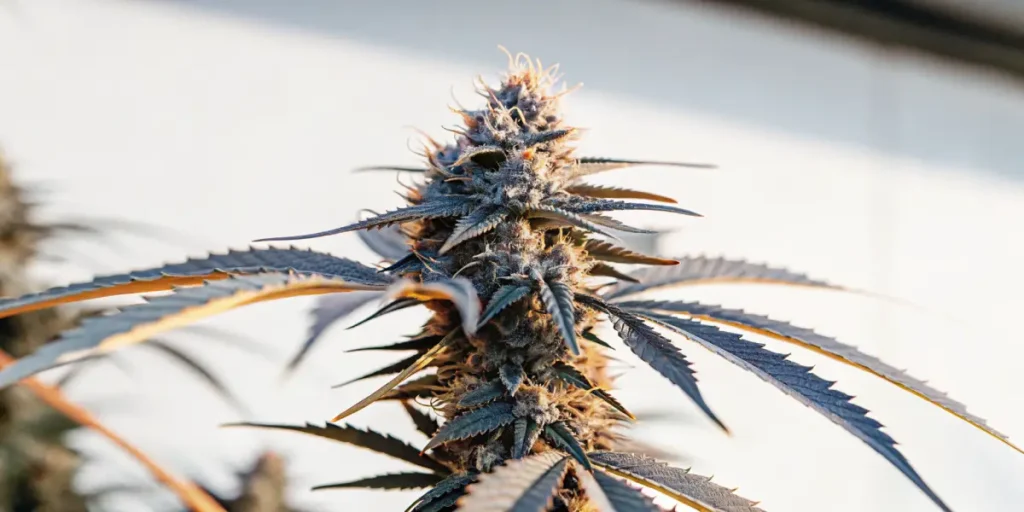
Harvesting & Drying CBG Force the Right Way
Harvesting CBG Force, a cannabis variety known for its high cannabigerol (CBG) content, requires carefully timed techniques to ensure its cannabinoid profile is preserved. Begin by recognizing the optimal harvest window, which is often when 75% of the pistils have changed color, indicating peak cannabinoid levels. It’s essential to observe trichomes through a magnifying glass or loupe; for CBG-rich strains, the trichomes should be milky and just starting to show a hint of amber, ensuring the highest concentration of CBG. Timing is crucial as harvesting too late can lead to degradation of the CBG into other cannabinoids.
Once you’ve determined the right time to harvest, proceed with cutting the branches carefully, preserving as much resin as possible. Avoid handling the flowers directly to maintain their delicate trichome structure. After cutting, trim away excess fan leaves to encourage airflow and prevent mold formation. Some growers opt to perform a rough trim at this stage and save the finer trimming for after drying. By maintaining the plant’s integrity during the initial cut, you preserve the valuable cannabinoids and terpenes.
Drying is a critical step to ensure the quality and potency of your CBG Force harvest. Hang the plants or branches upside down in a dark, well-ventilated space with temperatures ranging between 60-70°F (15-21°C) and humidity levels around 50-60%. This slow drying process, taking about 10 to 14 days, allows for the gradual evaporation of moisture, reducing the risk of mold while retaining the cannabinoid profile. Use of a dehumidifier or air conditioning can help achieve the optimal environment, ensuring that the drying process does not compromise the cannabis quality.
Once dried, the flowers are ready for further trimming and curing. Place the trimmed buds in airtight glass jars, opening them daily during the first couple of weeks to release moisture. This curing process, typically lasting 4 to 8 weeks, is essential for enhancing the flavor and aroma profile while stabilizing the cannabinoids, including CBG. Adequate curing also ensures a smoother smoking or consumption experience, maximizing the therapeutic potential of CBG Force. By following these careful harvesting and drying steps, you ensure a high-quality end product that reflects the desired CBG-rich properties of this unique strain.
cbg force Strain Type: Indica, Sativa or Hybrid?
The CBG Force strain is a fascinating addition to the world of cannabis cultivation, often raising questions about its classification. While most cannabis strains are categorized as Indica, Sativa, or Hybrid, CBG Force stands out due to its unique cannabinoid profile, predominantly expressing cannabigerol (CBG), a minor cannabinoid with emerging therapeutic potential. To determine where CBG Force fits within this classification system, we must consider its genetic lineage and growth characteristics to paint a clearer picture of its identity.
CBG Force is predominantly a hybrid strain, engineered to produce high levels of CBG while maintaining balanced growth traits reminiscent of both the Indica and Sativa varieties. The breeders of CBG Force aimed to harness the beneficial properties of CBG while ensuring that the plant itself could thrive in varied conditions. As a hybrid, it delivers on this promise, showcasing both Sativa-like vigor and Indica-like resilience. This blend makes CBG Force an accessible and rewarding choice for cultivators looking to explore the potential of CBG without the difficulties of maintaining a strain that’s too specialized.
In the garden, CBG Force exhibits traits characteristic of many modern hybrids. Its morphology tends to combine Sativa’s tall, lanky growth patterns with the bushy, denser structure associated with Indica plants. This mix results in a versatile strain adaptable to both indoor and outdoor environments, supporting a wider range of cultivation techniques. Moreover, the hybrid nature of CBG Force contributes to its balanced effects profile, appealing to consumers looking for relaxation without the pronounced sedative effects typical of pure Indica strains or the intense cerebral high of Sativas.
Whether one is experienced in cannabis cultivation or new to the practice, understanding the hybrid nature of CBG Force can enhance the growing experience. This strain not only provides the opportunity to explore the lesser-known effects of CBG but does so within a plant structure that’s forgiving and flexible. Its adaptability and ease of cultivation make CBG Force a significant addition to any cultivator’s repertoire, offering both an intriguing new challenge and a bridge to the broader world of cannabinoid science.
Why Grow CBG Force? Key Benefits for Cultivators
CBG Force is garnering significant attention among cannabis cultivators due to its unique properties and the potential benefits it holds. Cannabigerol (CBG) is often referred to as the “mother of all cannabinoids” because it is the precursor to other cannabinoids like THC and CBD. CBG Force strains are specially bred to produce high levels of CBG, making them stand out in the market. For cultivators, this specificity in breeding means that they have the opportunity to grow a plant that is not only innovative but also potentially lucrative as the demand for diverse cannabinoid profiles continues to rise.
One of the key benefits of growing CBG Force is the growing market demand for non-psychoactive cannabinoids. While THC has been the focus of cannabis breeding for many years, there is a notable shift towards cannabinoids that provide medicinal benefits without the high. CBG is becoming celebrated for its therapeutic properties, including its potential anti-inflammatory and neuroprotective benefits. As awareness and research into the benefits of CBG increase, cultivators have a unique opportunity to position themselves at the forefront of this burgeoning niche market.
Another significant advantage of cultivating CBG Force is the adaptability and resilience of the plant. CBG Force strains have been bred to thrive under various growing conditions, making them an excellent choice for both novice and experienced growers. These strains generally exhibit strong resistance to pests and diseases, which can lead to reduced dependency on chemical interventions. This resilience not only saves resources and enhances sustainability but also ensures a healthier crop yield. Consequently, cultivating CBG Force can be both economically beneficial and environmentally conscious.
Moreover, the production of CBG-dominant strains allows growers to diversify their product lines, catering to a wider array of consumer preferences. With the cannabis market becoming increasingly competitive, offering distinct cannabinoid profiles such as that of CBG can set a cultivator apart from the rest. The novelty and specific appeal of CBG Force can attract a specialized customer base, those particularly interested in alternative cannabinoids, thereby strengthening brand loyalty and market presence.
In summary, CBG Force presents cultivators with a unique opportunity to capitalize on an emerging sector within the cannabis industry. From tapping into new market demands to the potential health benefits and cultivation advantages, CBG Force provides numerous key benefits for those looking to innovate and expand their growing repertoire. As research continues to shed light on the versatility and benefits of CBG, cultivators can expect increasing interest and profitability from investing in this promising cannabinoid strain.
Potential Challenges When Growing cbg force
Growing CBG Force, a cannabis variety specifically bred to be high in Cannabigerol (CBG), presents unique challenges distinct from its THC-dominant counterparts. One of the primary issues is its genetic stability. As a relatively new strain developed to optimize CBG content, it may not yet have the genetic stability seen in older, more established strains. This can lead to variations in phenotypes, meaning that not all plants may exhibit the desired traits, such as high CBG content or growth characteristics, causing unpredictability in outcomes.
A second challenge is the appropriate optimization of growing conditions. CBG Force, like other cannabis strains, requires particular environmental conditions to thrive, but it may demand more precision in monitoring and adjustments. Factors such as light spectrum, temperature, humidity, and nutrient balance must be meticulously controlled to ensure that the plant expresses its CBG-rich potential fully. Many growers find it demanding to maintain these conditions consistently, especially if they lack advanced equipment or experience with cannabis cultivation.
In addition, harvesting CBG Force at the right time is crucial to maximize its CBG content. Unlike THC-dominant strains, which are often left to mature to maximize psychoactive effects, CBG must be harvested before it converts into other cannabinoids as the plant matures. This requires a precise understanding of cannabinoid development in the plant to determine the optimal harvest time. Lack of experience or technical knowledge could lead to harvesting too late, thus reducing the beneficial CBG content intended from these specialized cultivars.
Moreover, access to market expertise and resources may also pose a challenge. Given that CBG-dominant strains are relatively new in the cannabis industry, there are fewer resources and less accumulated knowledge available to growers, compared to more established strains. This can limit access to best practices or expert advice, making it difficult for growers to troubleshoot problems or refine their cultivation techniques efficiently.
Lastly, legal and economic factors may influence the cultivation of CBG Force. The legal environment surrounding cannabis varies widely by region, and specific regulations may exist concerning CBG or other cannabinoids, impacting the decision to grow these plants. Economic factors, including the demand and market price for CBG relative to other cannabis products, may affect the feasibility of growing this strain. Navigating these considerations requires careful planning and understanding of both the legal framework and market dynamics.
Is CBG Force Worth Buying? Here’s What You Need to Know
CBG Force is increasingly gaining popularity among cannabis enthusiasts for its unique properties and potential health benefits. But is it worth the investment for home growers? CBG, or Cannabigerol, is often referred to as the “mother of all cannabinoids” because it is the precursor to other well-known cannabinoids like THC and CBD. Unlike THC, CBG is non-psychoactive, meaning it won’t produce the ‘high’ commonly associated with cannabis. This makes it an attractive option for those seeking therapeutic benefits without the mind-altering effects.
One major factor that sets CBG Force apart is its potential health benefits. Research is still in the early stages, but preliminary studies suggest that CBG may have anti-inflammatory, neuroprotective, and antibacterial properties. It’s particularly noted for its potential in treating conditions like glaucoma and inflammatory bowel disease. Those looking for cannabis strains with these potential therapeutic effects might find CBG Force to be a compelling option, making it worth the investment for home cultivation.
However, growing CBG Force can present some challenges. It typically requires more precise environmental control and care compared to more common strains like THC-dominant or CBD-dominant strains. Additionally, because CBG is generally present in smaller quantities in cannabis plants, achieving high CBG levels means harvesting plants earlier in their life cycle, which demands a more strategic approach to cultivation. Therefore, growers should be ready to put in extra effort and attention to reap the benefits CBG Force has to offer.
Financially, investing in CBG Force can be more costly than traditional strains due to its rarity and the specialized growing conditions it necessitates. The seeds and plants may also come at a premium. However, for those particularly interested in exploring the unique therapeutic properties of CBG, the investment might prove worthwhile. When deciding if CBG Force is right for you, balance the potential therapeutic gains against the cost and effort required. For the dedicated grower passionate about cannabinoid exploration, CBG Force could be an exciting addition to your garden.

FAQs about CBG Force
What is CBG Force?
CBG Force typically refers to products or initiatives that are centered around Cannabigerol (CBG), a non-psychoactive cannabinoid found in cannabis plants. Known as the “mother of all cannabinoids,” CBG is being researched for its potential health benefits, such as reducing inflammation and improving neurological health. Products branded as CBG Force might indicate a focus on delivering high-quality CBG elements through supplements, oils, or other forms.
How does CBG differ from CBD and THC?
Both CBG (Cannabigerol) and CBD (Cannabidiol) are non-psychoactive cannabinoids, meaning they don’t produce the “high” associated with THC (Tetrahydrocannabinol), which is psychoactive. The main difference lies in their chemical structure and potential effects. While CBD is often used for its calming effects and wide range of health benefits like pain relief and anti-anxiety, CBG is gaining attention for its potential to stimulate appetite, reduce inflammation, and combat certain bacteria. THC, on the other hand, primarily engages the mind, altering perception and mood.
What are the potential health benefits of using CBG Force products?
CBG Force products are thought to provide several health benefits due to their high concentration of Cannabigerol. Studies suggest CBG may help with anti-inflammatory conditions, reduce intraocular pressure in glaucoma, and inhibit the growth of cancer cells. Moreover, CBG might enhance brain health by protecting against neurodegenerative diseases. However, research is still in its early phases, and further studies are needed to confirm these benefits conclusively.
Are there any side effects associated with using CBG Force products?
Currently, CBG is considered to have a favorable safety profile, with minimal side effects reported. The most common side effects might include nausea, dry mouth, or drowsiness, which are similar to those associated with CBD use. It is crucial to purchase CBG products from reputable sources to ensure quality and safety. Also, consulting with a healthcare professional before beginning any new supplement regimen is advisable, especially for individuals with existing medical conditions or those taking other medications.
Can I grow CBG Force outdoors?
Yes, CBG Force can be successfully cultivated outdoors, provided it receives at least six hours of direct sunlight daily and is planted in nutrient-rich, well-draining soil. Regular monitoring of temperature, humidity, and pests is crucial to ensure a healthy outdoor crop.

